We were in Rome for a week and a half.
- Church of Jesus [Church]: This church’s most amazing element was its frescoed ceiling. The way that it was executed, it really looks like figures are climbing into and out of it. This is hands down the coolest ceiling fresco I’ve ever seen, and I think it’s worth the visit for this alone. Also interesting is that there is a painting which, every day at 5:30 pm, recedes to show a statue (of the same subject) for half an hour. This was relayed to me by the very nice lady in the Church’s museum upstairs, who turned out to speak not only Italian, but also French. She also showed us statues of Saint Francis of Assisi, a Caravaggio painting, reliquaries like wine goblets, and bones of former priests.
- Santissimo Nome di Maria al Foro Traiano [Church]: This church was less memorable for me, though it did feel more intimate.
- Santi Cosma e Damiano [Church]:
 This church’s most interesting element was the ceiling above the altar, which appeared to be a mosaic. It had a beautiful teal color as its sky, with some Saints, and a number of sheep in a row below them. If you’re over by the Colosseum, you may as well stop in to admire the sheep.
This church’s most interesting element was the ceiling above the altar, which appeared to be a mosaic. It had a beautiful teal color as its sky, with some Saints, and a number of sheep in a row below them. If you’re over by the Colosseum, you may as well stop in to admire the sheep. - Sant’Andrea della Valle [Church]: I was sad that we couldn’t go inside this church, since the outside was pretty grand.
- Sant’Anastasia [Church]: We came here because of the name, though the inside isn’t as exciting as we might have liked. The plaza in front of the church is nice though, with benches and little trees that look like bonsai. Nice place to relax (if you ignore the car horns).
- Santa Maria Liberatrice [Church]: Some cool mosaics and stained glass were at this church in the Testaccio neighborhood, which is a bit out of the way.
- Church of Saint Augustine [Church]: There is a large Caravaggio painting in this church, for which it is best known. Though we didn’t know this, as soon as we walked into the church, B theorized that the painting was by Caravaggio! Amazing eye. And the painting was okay too.
- Santa Maria della Vittoria [Church]:
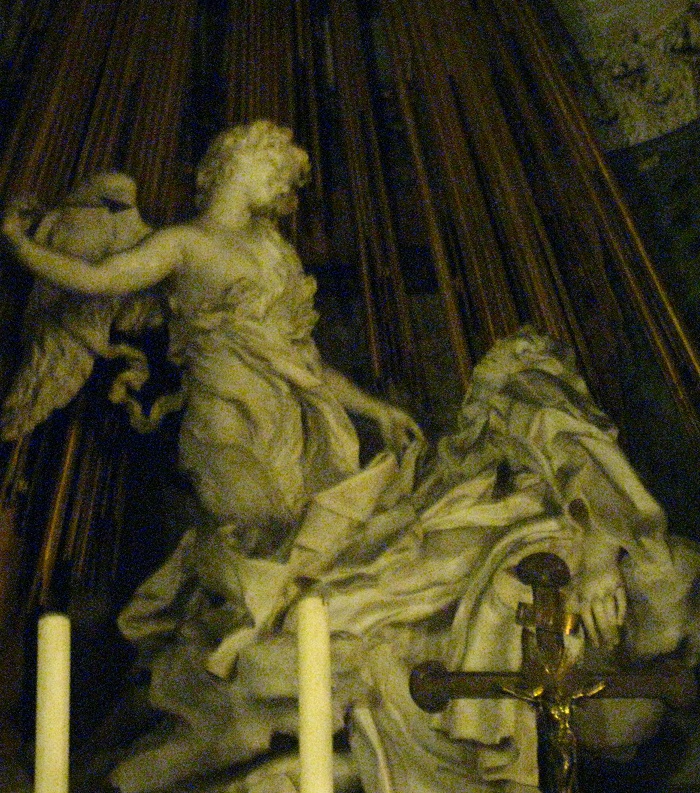 This church is known for its sculpture by master Bernini, called the Ecstasy of Saint Theresa. Not sure if I was just churched out or something else, but I actually enjoyed other decorations in the church more than this particular work.
This church is known for its sculpture by master Bernini, called the Ecstasy of Saint Theresa. Not sure if I was just churched out or something else, but I actually enjoyed other decorations in the church more than this particular work. - Santa Sabina [Church]: Though the ceilings in this church likely aren’t any taller than any of the others we’ve seen, they feel taller. In general, the design is a bit different. Perhaps it’s that the entrance is on the side, so you walk in with the altar on your right, not facing it. Maybe it’s because it seems more sparse and echoing. It has some interesting frescoes and mosaics, but it stood out just because the experience felt a bit distinct.
- Santa Maria Maggiore [Church]: This is one of those churches that is really part of Vatican City, despite not actually being in Vatican City. It is huge, and it has a bunch of large separated chapels, with various religious leaders conducting services there, sometimes at the same time. There is a crypt in there, said to hold a piece of the wood from Jesus’ original crib. There is also a huge altar with mosaics on it, and elaborate decorations of so many types that it’s overwhelming. Bernini and a bunch of Popes are buried here, and the art is some of the oldest and most famous in the city. Worth seeing.
- Pantheon [Church]:
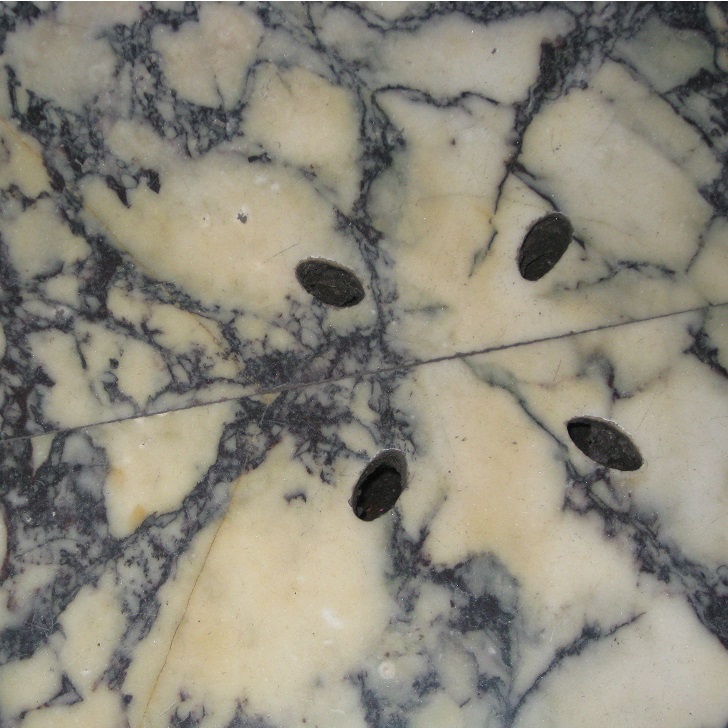 This famous landmark turns out to be a classical-looking building with a chapel and memorials inside. They believe the turning of the building into a church so early in history is what helped it survive to be such a well-preserved structure. This is somewhat ironic, since the name of the building (‘Pantheon’) refers to ‘many gods.’ Despite the monument’s popularity, I didn’t know much about it before going. Turns out that it has a big (on-purpose) hole in its dome, which is a marvel of engineering, since the dome is made of concrete. To make it sturdy, the concrete was thinned towards the center, which was considered very advanced for the time. Towards the entrance, there is a big sign answering the most-frequently-asked question about the landmark: what happens when it rains? It turns out that there are 22 holes in the marble floor for drainage – though for reasons I don’t understand, the sign indicated that rain rarely comes through the opening. Aside from all this, inside are the tombs of two Italian emperors and Raphael – of teenage mutant ninja turtles/artistic fame. Maybe it was when we went, but I found it surprisingly uncrowded, compared to the Colosseum, for example.
This famous landmark turns out to be a classical-looking building with a chapel and memorials inside. They believe the turning of the building into a church so early in history is what helped it survive to be such a well-preserved structure. This is somewhat ironic, since the name of the building (‘Pantheon’) refers to ‘many gods.’ Despite the monument’s popularity, I didn’t know much about it before going. Turns out that it has a big (on-purpose) hole in its dome, which is a marvel of engineering, since the dome is made of concrete. To make it sturdy, the concrete was thinned towards the center, which was considered very advanced for the time. Towards the entrance, there is a big sign answering the most-frequently-asked question about the landmark: what happens when it rains? It turns out that there are 22 holes in the marble floor for drainage – though for reasons I don’t understand, the sign indicated that rain rarely comes through the opening. Aside from all this, inside are the tombs of two Italian emperors and Raphael – of teenage mutant ninja turtles/artistic fame. Maybe it was when we went, but I found it surprisingly uncrowded, compared to the Colosseum, for example. - Great Synagogue of Rome [Synagogue]: We ambled here by accident, in our search for the culinarily-famous ‘Roman Jewish Artichokes.’ The museum inside this synagogue was pretty well done, and the tours of the two sanctuaries were good. It would have been neat to see the original building in this neighborhood (read: ghetto), but that was long gone. Our timing was good though, since they were setting up for a wedding being held in there that evening; there was a white runner and lots of flowers being arranged by teenage boys. (Fun fact: Italians/Romans don’t call them Jews.)
- Trajan’s Column and Market [Ruins]:
 This is a tall column, but the description of its every component takes up much more space than it does. The internet says that this is because it was one of the original ‘triumphal columns,’ which inspired many others. Sadly for Emperor Trajan, whose victory it celebrated, Pope Sixtus replaced his statue on top with one of St. Peter. The market next to the column is said to have been the first-ever ‘shopping mall.’ Today, there are some modern art sculptures in there, which are cool, but not amazing enough to go out of your way for it.
This is a tall column, but the description of its every component takes up much more space than it does. The internet says that this is because it was one of the original ‘triumphal columns,’ which inspired many others. Sadly for Emperor Trajan, whose victory it celebrated, Pope Sixtus replaced his statue on top with one of St. Peter. The market next to the column is said to have been the first-ever ‘shopping mall.’ Today, there are some modern art sculptures in there, which are cool, but not amazing enough to go out of your way for it. - Colosseum/Flavian Amphitheatre [Ruins]: You should go here and experience it. Buy your ticket at Palatine Hill (same ticket, whether you go to both or not), where the line is shorter. Unfortunately, I was not as enamored of this giant amphitheatre as I should have been. Imagine something that looks like a modern-day football stadium, except a bit smaller and with a subterranean level where people and animals prepared for the main event. This event was often a showdown between two opponents, each either man or animal. I reveal my ignorance here, but I thought that gladiators primarily fought for glory or to improve their social standing; turns out, they mostly fought because they had to, to avoid death. And the gladiator fights were secondary to the epic battles, on the order of tiger versus lion. So, I was expecting American Gladiator (yes, the 90s TV show) or Ben-Hur, and instead, it was more like modern-day brutal dog fighting rings. Also interesting is that a former Pope declared the site to be the location of historical Christian martyrdom, despite having no historical evidence whatsoever to substantiate this. I have two theories about why he would have done this. The benevolent: people have been stripping the amphitheatre for parts since its construction, so perhaps the Pope wanted to help preserve this historical monument before looting destroyed it. The less benevolent theory is that he wanted a piece of both the conversation and the ownership rights. The final mystery for me is why the landmark is known for a statue (the Colossus) that stood near it a long time ago.
- Palatine Hill [Ruins]: This was a nice walk among ruins, though the structures themselves weren’t the coolest ones in the city. But it’s large enough that the crowds are thinner, and there’s a nice breeze on the hill up there.
- Theatre of Marcellus [Ruins]: These ruins don’t seem that big, though I imagine that the original was not too different from the size of the Colosseum. So little is standing though, that the grandiosity is nowhere near the same. I also read that they still host summer concerts here, though it’s a mystery how they could possibly cram many people in there.
- Largo di Torre Argentina [Ruins]:
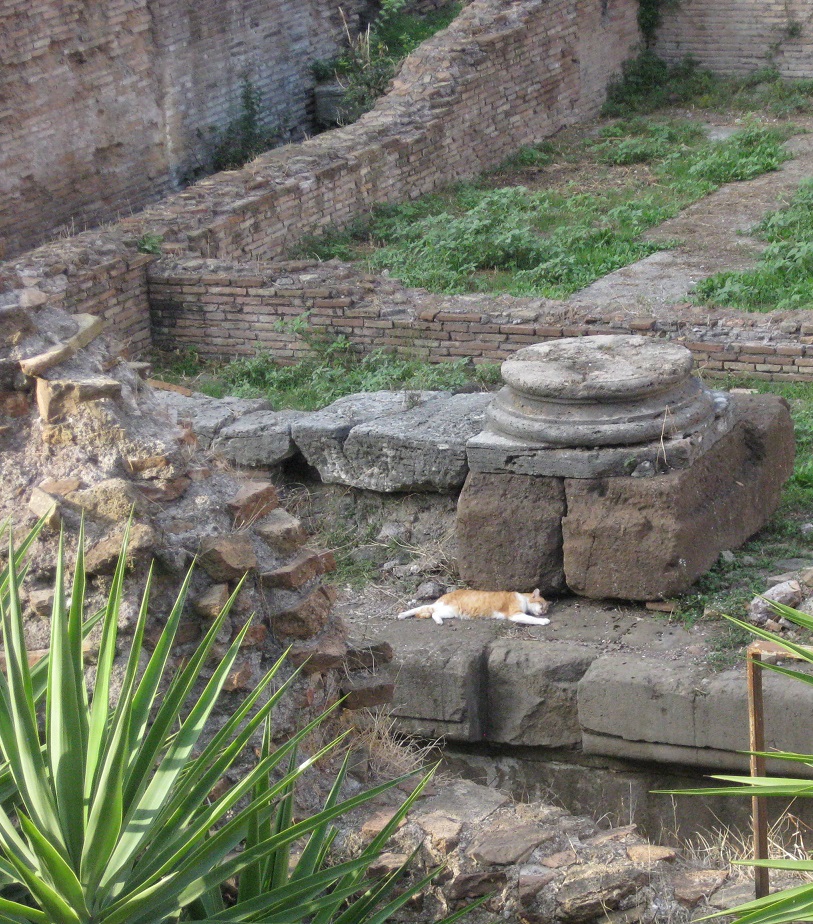 This set of ruins is known for being home to many wandering felines. When the site was thoroughly excavated in the 1990s, a particularly large number of cats decided to make it their home. Local ‘cat ladies’ fed and cared for the feral kitties, and in 1998, two of them formally set up a foundation specifically for their care. Now, 300+ cats live on-site, sleeping in the sun on the dilapidated marble columns of former emperors. Cats aside, these ruins are said to be of the old Pompey Theatre, which is where Caesar was assassinated. Alas, no statue or spectacle commemorates this infamous event, so you’ll have to use your imagination.
This set of ruins is known for being home to many wandering felines. When the site was thoroughly excavated in the 1990s, a particularly large number of cats decided to make it their home. Local ‘cat ladies’ fed and cared for the feral kitties, and in 1998, two of them formally set up a foundation specifically for their care. Now, 300+ cats live on-site, sleeping in the sun on the dilapidated marble columns of former emperors. Cats aside, these ruins are said to be of the old Pompey Theatre, which is where Caesar was assassinated. Alas, no statue or spectacle commemorates this infamous event, so you’ll have to use your imagination. - Temple of Apollo Sosianus [Ruins]: Sadly, underwhelming. The nearby Hercules and Portuno temples were cooler, in my opinion.
- Temple of Portuno / Temple of Hercules Victor [Ruins]: These are the most unmobbed ruins in Rome, I think. Sad, since they’re pretty intact small temples. Now you can’t go inside, but if you want a great photo or if you have a hard time filling in the gaps on ruins, this is the place for you.
- Arch of Janus [Ruins]: Despite its name, this giant gate was never dedicated to the god Janus. It was so named because it faced all four directions, a rarity. In older times, traders would stand underneath it to conduct business. Now, either this was just a subset of them, or they were all ridiculously thin, because the arch wasn’t that big. Don’t go out of your way, but if you’re here, walk on by.
- Circo Massimo [Ruins]: Calling this a ruin is generous, since it’s mostly a giant football-field-looking empty space, where they used to race chariots. Sounds cool, right? Not so much. I hear they have summer concerts here, in which case it would be worth it; otherwise, just rent Ben-Hur.
- Campo dei Fiori [Market]: I love markets, but not the tourist varieties. This market was unfortunately mostly a souvenir shop laid out on wooden tables, surrounded by tourist trap restaurants. I suppose it’s possible that some locals come here to buy olive oil in a bottle shaped like Italy, or some persimmons, but I am skeptical. Skip this.
- Piazza Navona [Plaza]: Don’t rely on Google Maps to get you here, because it thought this plaza was in the middle of a random building. But if you have a chance, meander here at night. There is a cool fountain (Fountain of the Four Rivers), cute shops strung in lights, plenty of benches, and some pretty good street musicians. I normally don’t mention plazas, since we wander through hundreds of them, but this was a particularly relaxing one.
- Pyramid of Caius Cestius [Monument]: This is a mini pyramid right next to a pretty big subway station, away from most sights. It was originally intended to be a tomb for a man puffed up with his own consequence, though you can’t go in now unless you’re a professor. Not worth it unless you’re over there already.
- Spanish Steps [Monument]:
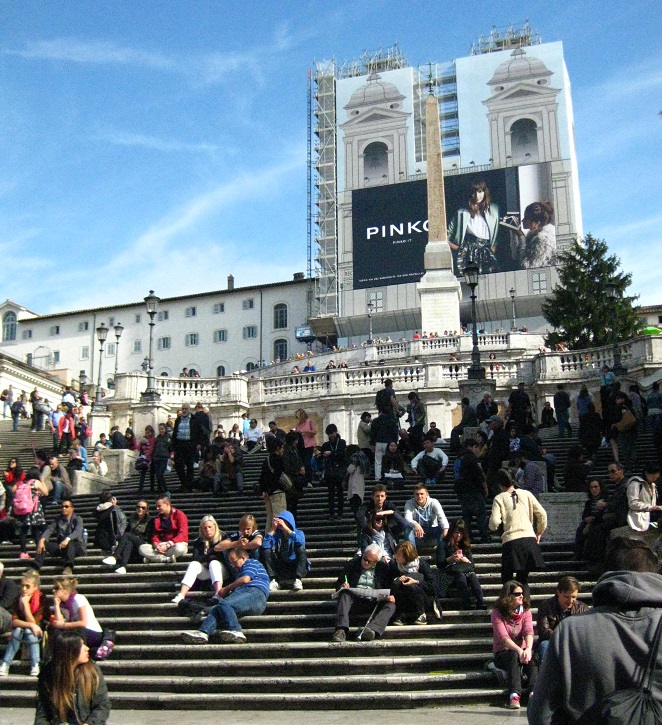 I was a bit excited about these stairs, because I had read that the architect had an unusual idea for them: having them go in different directions. I was imagining the innovation of someone like Gaudi. After all, the article said that artists were so inspired by the design that they would often paint or write there. This attracted beautiful women hoping to be their models to the spot, which, in turn, drew wealthy men and tourists and the general mob. The story is fun, but unfortunately, the reality did not live up to it. I’m having trouble imagining what would have been novel about the design, even ignoring my contemporary knowledge of stairs. To be fair, when we were there, the plants along the stairs were not in bloom, and the church behind was engulfed in scaffolding featuring a giant clothing ad. However, even at the best of times, it seems like it would still be a place where tourists sit eating sandwiches and smoking. Not my idea of fun.
I was a bit excited about these stairs, because I had read that the architect had an unusual idea for them: having them go in different directions. I was imagining the innovation of someone like Gaudi. After all, the article said that artists were so inspired by the design that they would often paint or write there. This attracted beautiful women hoping to be their models to the spot, which, in turn, drew wealthy men and tourists and the general mob. The story is fun, but unfortunately, the reality did not live up to it. I’m having trouble imagining what would have been novel about the design, even ignoring my contemporary knowledge of stairs. To be fair, when we were there, the plants along the stairs were not in bloom, and the church behind was engulfed in scaffolding featuring a giant clothing ad. However, even at the best of times, it seems like it would still be a place where tourists sit eating sandwiches and smoking. Not my idea of fun. - Trevi Fountain [Monument]: This famous landmark is unfortunately under construction for another year, which means scaffolding and fountainlessness. They have a walkway past the sculptures of the front, which means you get closer than you ever would be able to, but it’s not very exciting at all. Skip it if you’re going before October 2015. (Probably after that too, but that’s just me and tourist traps.)
- Mouth of Truth [Monument]:
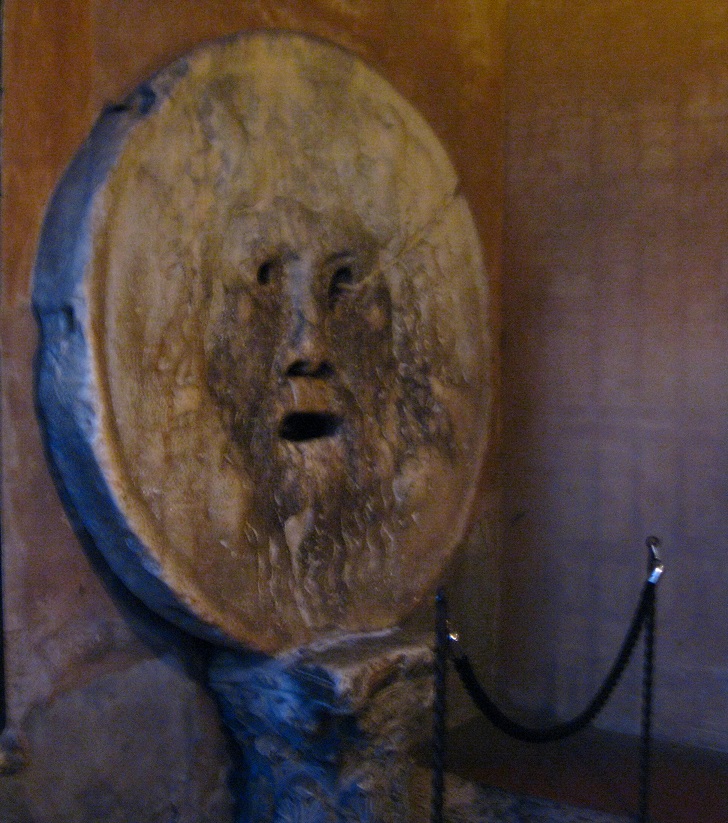 This is one of those spots were people queue forever, to take a rushed photo with this item and move on. The item itself is a stone face in the wall of a church, which is nothing too special – until you hear the myth around it. You are supposed to stick your hand into its open mouth while saying something: if you’re lying, your hand will be chopped off. Obviously, they have un-choppified the thing, to prevent an epidemic of hospital visits. However, if they ever need to drum up business…
This is one of those spots were people queue forever, to take a rushed photo with this item and move on. The item itself is a stone face in the wall of a church, which is nothing too special – until you hear the myth around it. You are supposed to stick your hand into its open mouth while saying something: if you’re lying, your hand will be chopped off. Obviously, they have un-choppified the thing, to prevent an epidemic of hospital visits. However, if they ever need to drum up business… - Knights of Malta Keyhole [Monument]: The Knights of Malta order has been taking care of the sick for centuries. They have been doing this in supposedly-hideous powder blue uniforms while under a lifelong vow of chastity. So, I think they deserve their prime real estate on Aventine Hill, from where they have a fabulous view of the city and of the Vatican. If you look into the keyhole in their gate, the garden inside frames the dome of St. Peter’s Basilica quite perfectly. I find it a bit odd that they don’t mind the long line in front of their gate, nor do they collect donations there. I wouldn’t trek up here just for this, but if you decide to climb one of Rome’s famous seven hills, this is a nice part of the visit.
- Orange Garden [Park]:
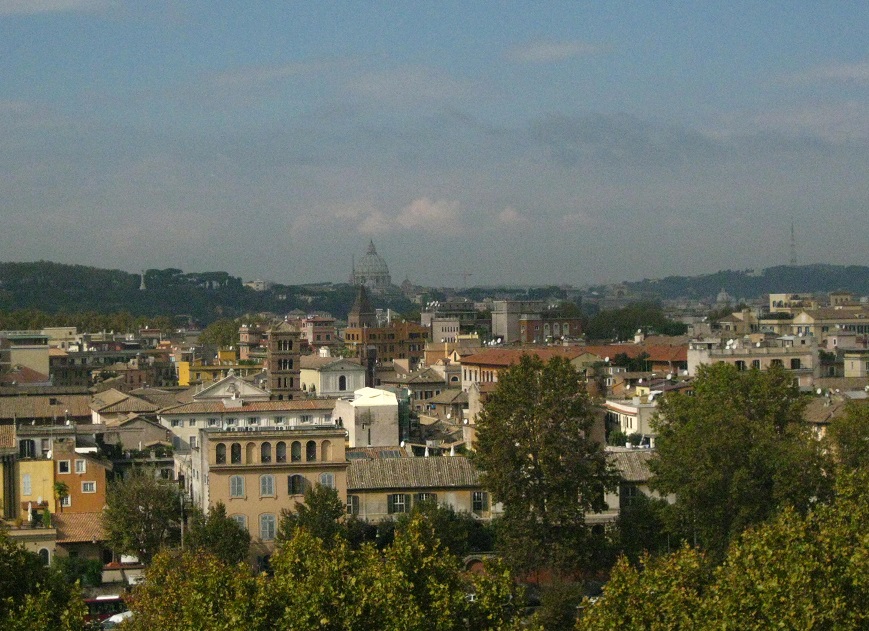 This is a small park next to the Saint Sabina church, where I sadly didn’t see any of the eponymous orange trees. However, it’s got a great view over the city, including St. Peter’s. Very peaceful.
This is a small park next to the Saint Sabina church, where I sadly didn’t see any of the eponymous orange trees. However, it’s got a great view over the city, including St. Peter’s. Very peaceful. - Villa Borghese Gardens [Park]: This was a nice, relaxing place to walk through in the middle of the city. They had plenty of Segway and quad bike rentals, so people were careening around the gravel paths in their chosen conveyance. There were some statues and a cafe inside, and cars drove through the center, like they do through Central Park – though not nearly as big. The jewel of the park, though, is the Galleria Borghese.
- Galleria Borghese [Museum]: Given its fame, I thought that this museum would be as big as the Uffizi or the Louvre; not true. You can see the most famous sculptures and paintings if you click through, but I was actually most taken by two things not listed there: (1) They had created black glass versions of some of the paintings, which were like unique holograms. and (2) There was a spinning sculpture that worked like cartoon flip books, in which the quick transition from scene to scene makes it seem like a movie instead of a still. The villa that houses the museum has a few interesting interior design elements too. Knowing what I do now, I might well have skipped this museum – though some will call that blasphemous. However, if you do go, know that it won’t be the all-day affair that a trip to the Louvre would be. Just make sure to make a reservation.
- Capuchin Crypt [Museum]: (Photography is not allowed in here, so click through to see what this looks like.) They say that a big part of the true Rome is underground, mostly in old tombs. That makes sense, given how many grave memorials they have above ground, from the Castel’Angelo to Umberto in the Pantheon. Anyway, I thought this was a thing to check off the list, just to have seen it. Well, turns out the reason it’s on the lists is because Romans want to scare the bejeesus out of tourists. They start you off in the museum dedicated to the Catholic friars called capuchins; it seems like a normal museum, with relics and stories about the friars and martyrs. And then they introduce you to the crypt, saying there are various theories on its origin. The most popular one is that a bunch of the friars barely escaped France during its guillotine phase and hid here underground, waiting for the beheadings to end. It was a long wait, and they were bored, so they got creative with the other ‘occupants’ of their lair: three thousand people’s bones. How can I describe how creepy this place is? Imagine an OCD friar, who decided to organize all the dead people’s bones into different rooms, by body part: the skull room, the leg bone room, etc. And then, an artist friar came and messed with his organization, making home decor out of people parts: lamp holders made of pieces of spine, jaws in the shape of wall art, etc. Then, the artist friar applied interior decorating principles, to give each room a focal point. In many cases, this was a few full skeletons dressed in friar frocks; however, some of the skulls still had mummified skin on them, and one was making a scream-like face. If you are not creeped out after reading all this, then I am not describing it well.
- Giorgio de Chirico House [Museum]:
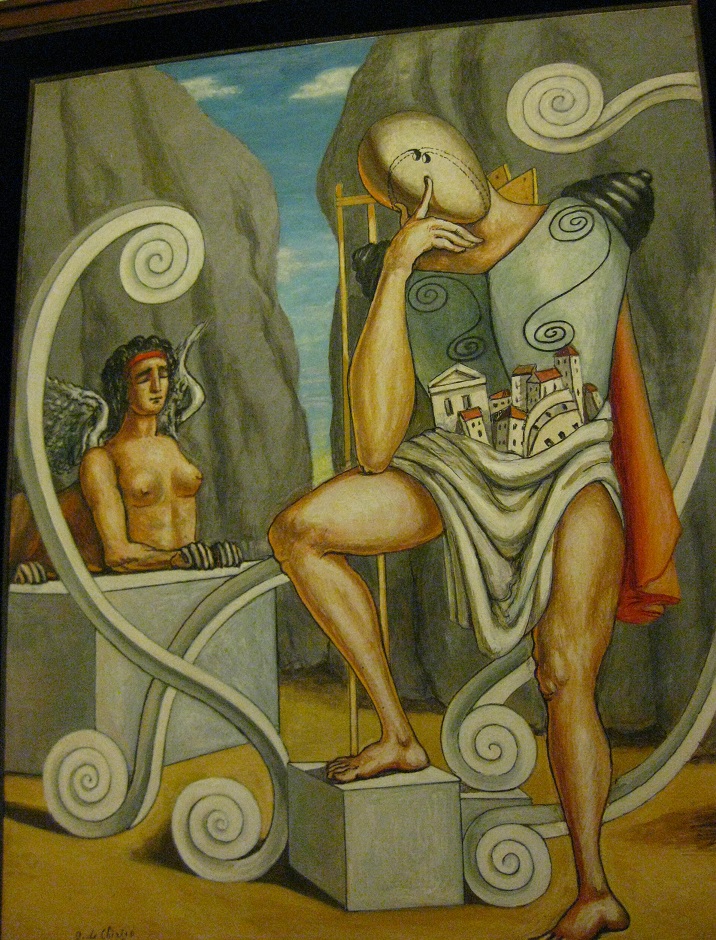 We came here mostly because I thought this was the same as the Chiostro del Bramante museum. (Newsflash: it’s not.) It is the private home and studio of a 20th century artist. The foundation that now owns his place conducts private, daily, reservation-only tours, showing the works he kept in his home. We both really liked it because (a) the artist’s style seems unique, compared to others we’ve seen; (b) the tour itself was pretty well-run, educational, and intimate; and (c) B appreciated getting a sense for how a 20th century artist spent his days living and working.
We came here mostly because I thought this was the same as the Chiostro del Bramante museum. (Newsflash: it’s not.) It is the private home and studio of a 20th century artist. The foundation that now owns his place conducts private, daily, reservation-only tours, showing the works he kept in his home. We both really liked it because (a) the artist’s style seems unique, compared to others we’ve seen; (b) the tour itself was pretty well-run, educational, and intimate; and (c) B appreciated getting a sense for how a 20th century artist spent his days living and working. - Chiostro del Bramante [Museum]: The main exhibit at this museum was advertised around town, which is what got our attention. It was on M.C. Escher, who we both like and appreciate. It was a really cool exhibition, with many of his most well-known works and with hands-on explanations of the optical illusions he used. The one thing that was unusual was that it was really Escher’s life in the context of Italy (where he lived for about a decade, prior to Mussolini’s rise to power), not his life overall. B thought that it was Italy’s attempt to try to stay relevant in modern art, which may well be true. I think it also brought locals into the museum: I heard very little English. Museum agenda aside, there was a lot to appreciate. It was one of our favorite things we did in Rome.
- Castel Sant’Angelo
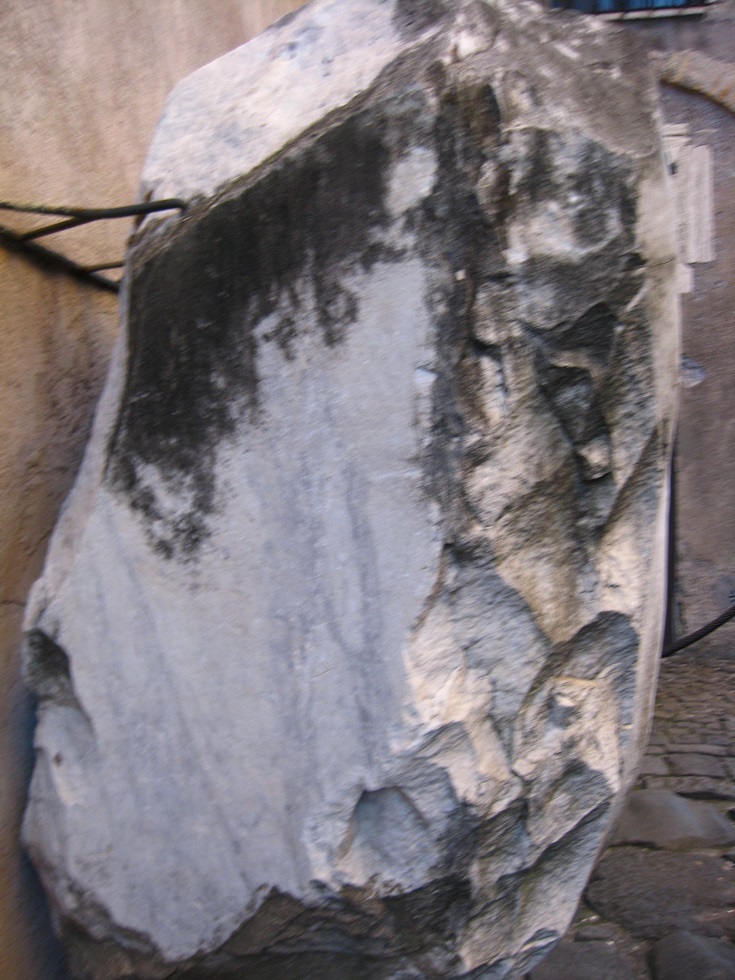 [Museum, View]: Emperor Hadrian initially built this to be his tomb building, though subsequent leaders did not have as high an opinion of his consequence as he did, choosing to build over it. It was used as a castle/palace for some rich people, and it served as a fortress for a long time. There is a very long brick passageway to it from the Vatican, intended to help Popes escape sudden seiges, and one Pope even did. With all of this restructuring, the building ends up feeling much like a maze – which makes it more interesting than the other ruins we visited. There are still cannon balls and catapults on display, though I presume that’s for the tourists. There are ruins that look like big rocks, labeled ‘Fragment of Sculpture,’ as if we might confuse them for gazelles if they weren’t thus marked.
[Museum, View]: Emperor Hadrian initially built this to be his tomb building, though subsequent leaders did not have as high an opinion of his consequence as he did, choosing to build over it. It was used as a castle/palace for some rich people, and it served as a fortress for a long time. There is a very long brick passageway to it from the Vatican, intended to help Popes escape sudden seiges, and one Pope even did. With all of this restructuring, the building ends up feeling much like a maze – which makes it more interesting than the other ruins we visited. There are still cannon balls and catapults on display, though I presume that’s for the tourists. There are ruins that look like big rocks, labeled ‘Fragment of Sculpture,’ as if we might confuse them for gazelles if they weren’t thus marked.  The rooms have rotating exhibits: when we went, they had one on Christian art in Rome, one on armor, and several showing the frescoes and furnishings once used in the castle. All along the way up are 360 degree views of the city, but the top is the best – especially at sunset. You are right next to the dome of St. Peter’s Basilica, and much of the city is laid out before you. Worth it.
The rooms have rotating exhibits: when we went, they had one on Christian art in Rome, one on armor, and several showing the frescoes and furnishings once used in the castle. All along the way up are 360 degree views of the city, but the top is the best – especially at sunset. You are right next to the dome of St. Peter’s Basilica, and much of the city is laid out before you. Worth it.
What We Skipped:
- Archbasilica of St. John Lateran [Church]: This is a pretty important church: more important than St. Peter’s Basilica in the Vatican! This wasn’t quite on our way to anywhere though.
- Basilica of Saint Paul Outside the Walls [Church]: Ditto with the church overload.
- Ostia Antica [Ruins, Park]: This was supposed to be a cool area to walk around, but it’s a train ride from the city, so we opted out.
- Colombario di Pomponio Hylas [Ruins]: This is supposed to be one of the best-preserved underground tombs in the city. However, it turns out that getting down there requires a reservation in advance and a personal letter from the Pope. (Okay, that second part is just what it feels like it requires.) We settled for the Capuchin Crypt instead.
- Baths of Caracalla [Ruins]: We made quite an effort to see these ruins of a fancy bath complex. However, I mis-directed us to the southern end, instead of the northern one. And it turns out that the most exciting thing at the southern end is a (plant) nursery called Eurogarden. Oops.
- Appian Way [Ruins]: This was supposed to be a pilgramage path: the very old road into the city. Lots of ruins, not enough reason to go for us.
- Modern Art Museum [Museum]: I’m all about Italy’s definition of ‘modern art,’ which is most other countries’ late 19th/early 20th century art. However, the listing of what was at this museum was pretty paltry, so we went to other museums instead.
- Victor Emmanuel Monument [Museum, View]:
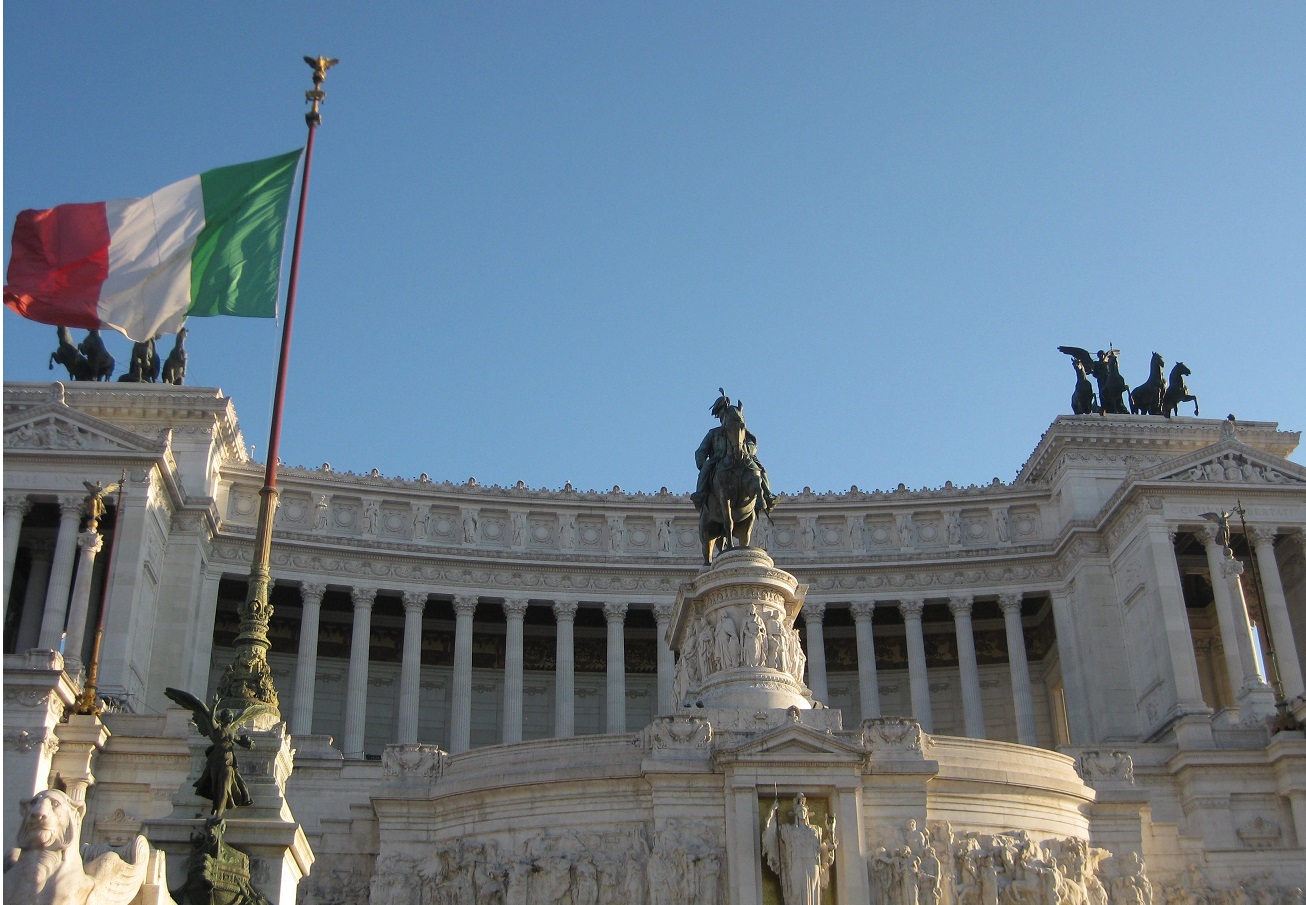 We picked the Aventine Hill view over the one from this building’s elevator, and it was too crowded to try to push through to the museum inside. We passed it a million times though: the traffic circle in front of it is one of those monstrosities of traffic and city life that is a lot more interesting than the ruins, in my opinion.
We picked the Aventine Hill view over the one from this building’s elevator, and it was too crowded to try to push through to the museum inside. We passed it a million times though: the traffic circle in front of it is one of those monstrosities of traffic and city life that is a lot more interesting than the ruins, in my opinion. - Palazzo Doria Pamphilj [Museum]: This is said to be “one of Rome’s biggest and most significant private artistic collections,” but we didn’t make it there.
- Mosque of Rome [Mosque]: Sadly, this didn’t show up on any sightseeing lists, so we didn’t even know to look for it. It is said to be the biggest in Europe.
- Tiber Island [Park]: It’s interesting to have an island in the Tiber River, but the island mostly houses a hospital, so it didn’t seem worth it.



Pingback: What We Saw in Vatican City - Novelty Buffs
Pingback: What We Saw in Osaka - Novelty Buffs